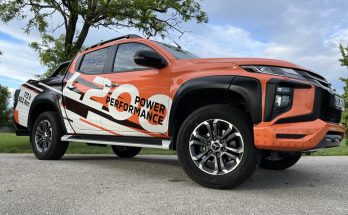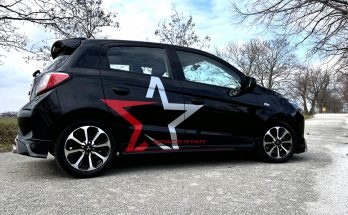The new Outlander returns to the roots and sharp sporty shapes that presented the first and second generations. The current, third-generation Outlander looked like one big balloon when it was launched – everything was rounded and inflated, which made the car lose a little of its original sharp appearance and look dull. However, the first facelift improved it, and the current last one is already betting on sharper shapes, so the Outlander looks more predatory and aggressive. From the outside, the latest incarnation of the Outlander, thanks to several optical changes, appears a little smaller than its predecessor, but the opposite is true.


In addition to the new design of the front mask, radiator grille and rear spoiler, the current facelift for 2019 also brings a number of other novelties, such as Bi-LED headlights that wrap around the body (including daytime running lights composed of 12 diodes), which are gently pulled upwards and to the hips, which further emphasize the feeling of dynamism. Also new is the design of the 18'' wheels, modified shape of the seats and their materials, new design of the central armrest with ventilation vents for passengers on the back seats, higher rigidity of the body thanks to glued joints, improved front and rear shock absorbers and larger brake discs, or another reduction engine noise. In the rear part, we find a chrome decor stretching across the elongated combined LED lights.


Outlander belongs to SUVs that can accommodate up to 7 passengers in its interior. In the end, it was Mitsubishi that defined this category in its time with the Outlander. There is enough space for three people in the second row, and even an adult can sit quite comfortably on the last two folding seats. However, he has to count on limited support in the shoulder area, and there is not much legroom either. However, the crew has plenty of headroom, even on the rear seats, which are sliding, and the second row of seats even has reclining backrests.


The driver and passenger in the front seats also have enough space in all directions and are surrounded by a driver-oriented dashboard, which received a slight modernization in the form of a new infotainment display. It is no longer an outdated display with a selection panel of buttons, but a full-fledged touch screen with fine graphics, a decent response and a lot of functions. Both Android Auto and AppleCar Play are present and working on the unit. Since I don't use the built-in navigation, I wasn't even bothered by the absence of this function (even though Outlander has a GPS module – satellites and position in coordinates can be displayed). I was a little irritated by the used automatic transmission selector lever, which certainly remembers the 90s in design, but that is probably the only flaw of beauty that I am happy to forgive.


The luggage space reaches up to 667 liters, which increases to 1608 liters when the rear seats are folded down. It has a cuboid shape, a relatively low loading edge and is very accessible. However, I struggled a bit with folding the seats in the second row. However, a flat floor is not created when the seats are folded down, and you will have to load longer objects "at an angle" over the edge. Crew storage is plentiful everywhere, and even the two passengers in the third row can fit in and store items in the left-hand box or two large drinks in the right-hand compartment. On the left in the luggage compartment we find a great subwoofer with a protective grille and next to it an even smaller storage recess. On the other hand, we find its full-fledged version, where you can easily hide a first aid kit, a rope, a net and the like. Under the folding rear part there is a box for mandatory equipment and in front of it folding seats.


The enjoyment of refined driving in the new Outlander is based on comprehensive measures to reduce noise, vibration and vibration, namely noise from the engine and its rumbling manifestations (resonance), wheel noise from the road or aerodynamic noise. According to available information, Mitsubishi has improved more than 30 different areas within the entire vehicle – the body, the engine, the suspension, the wheels themselves, the sound-insulated glass, the dynamic dampers built into various places and components, etc. – up to the modifications of the door sealing system in order to achieve a higher-quality damped click when the door is closed. It all works as a unit, and driving this large SUV is exemplary quiet and smooth. You just don't see such a well-tuned chassis in an SUV.


In the motorization tested, Mitsubishi did not use a classic automatic with a hydrodynamic converter or a double-clutch box. A CVT transmission, which does not have permanent gears, was added to the board. This type of gearbox is widespread especially in Asian countries and in our geographical regions it is an underappreciated rarity. From a design point of view, this type of gearbox has a problem with the transmission of high torque and is therefore mostly used in combination with atmospheric units. In order for the transmission to be accepted by Western customers, the automaker also "stocked" it with pre-prepared gear stages. As a result, the advantages of a classic gearbox and a CVT are combined.
The Outlander has never been and is not a sports car, which is why the CVT suits its character. This applies both to quiet driving and to driving in off-road or crowded cities. The gearbox does not recognize a jerk when shifting, and in principle it is not even possible. It's all about getting used to and realizing how this mechanism works. Thanks to the artificial gear ratios, when the gas is fully pressed, the engine does not rev but simulates a classic gearbox. When the drive unit is under low load, the transmission keeps the lowest gear possible, and with gentle throttle work, it is possible to drive at a constant 2000 rpm even with acceleration. When driving calmly, the 2.0-liter four-cylinder gasoline engine with an output of 110 kW (150 hp) and a maximum torque of 195 Nm pays off with refined operation and decent consumption. In the combined mode, my fuel was running out of the tank at a rate of 8.7 l/100 km, which is a very good value for such a large car and fully corresponds to what the manufacturer states. During my work trips on county roads, I could even drive with it for 6.5L/100km.


The tested Outlander accelerates from 0 to 100 km/h in about 12 seconds. The maximum speed is set at 190 km/h. An SUV equipped in this way will satisfy drivers who do not suffer from high performance but prefer a quiet ride. The atmospheric MIVEC unit will definitely repay them with a long service life compared to smaller turbo motors and will be easy to maintain without high service costs. If you are not looking for a sports car, you will be satisfied with a smaller dose of dynamics, but if you want to drive off-road, you may have found an interesting offer.
The drive of both axles as standard sends power to the front wheels. If necessary, the rear axle is also connected, but the driver can lock the power distribution in the ratio 50:50 between the front and rear axles with the controller. The steering and chassis correspond correctly to the used engine and transmission, and their main goal is to achieve the comfort of the driver and the crew. This means that the steering gives the driver less feedback via the steering wheel and the chassis filters out bumps at a very high level. As for the 4×4 drive, it is one of the more honest ones. Mitsubishi, as one of the few manufacturers on the market, offers an all-wheel drive system with 9 information evaluation sensors. According to my information, only the Subaru brand has a comparable number of sensors. Other competitors have an average of 4 sensors.


In addition, Outlander has an electromagnetically controlled viscous clutch, which is an advantage over Haldex, as it reacts faster to changes in adhesion conditions than Haldex. The electronically controlled clutch allows the driver to partially influence the operation of the quad (unlike Haldex).


When parking with a large SUV, four cameras with a relatively good image and resolution make life easier for the driver. In the 360 degree mode, you can also switch to a side view of the front wheel, which is very suitable for off-road and when parking close to curbs.
In addition to the lane departure warning system (LDW), adaptive cruise control (ACC) and forward collision mitigation (FCM), the range of safety systems in the new Outlander has been expanded to include an ultrasonic system to prevent unwanted acceleration (UMS). The aim of this system is to prevent the vehicle from colliding with an obstacle in case of unwanted acceleration of the vehicle. If the driver inadvertently depresses the accelerator pedal in situations where the ultrasonic sensors detect an obstacle at a distance of up to 4 meters in the direction of travel and the vehicle is currently parked (selector in position R or D) or is driving at low speed (up to 10 km/h), the driver is alerted by a warning sound and a message. At the same time, the UMS system regulates the engine torque to prevent possible damage in the event of a collision with an obstacle.

Conclusion
The Outlander may seem a bit like a car from the past, but Mitsubishi managed to keep it a competitive and full-fledged modern SUV by adding modern technologies.
All this at a price that doesn't have many competitors. In the highest equipment, Instyle+, with additional metalwork (€600) and accessories (€840), the total price is €33,330 including VAT. Try to find a 7-seater SUV with full 4×4 drive and comparable safety and comfort equipment on the current market…
| Technical specifications | Mitsubishi Outlander 2.0 MIVEC 4WD CVT |
| Engine type: | Spark plug |
| Cylinders / valves: | 4 / 16 |
| Displacement (ccm): | 1998 |
| Highest power (kW(k) / rpm) | 110 (150) / 6000 |
| The highest twist. torque (Nm / rpm): | 195 / 4200 |
| Gearbox: | CVT |
| Acceleration 0 – 100 km/h (s): | 10.9-12.1 |
| Combined consumption – WLTP (l/100 km): | 8.7 |
[rl_gallery id=”4780″]




